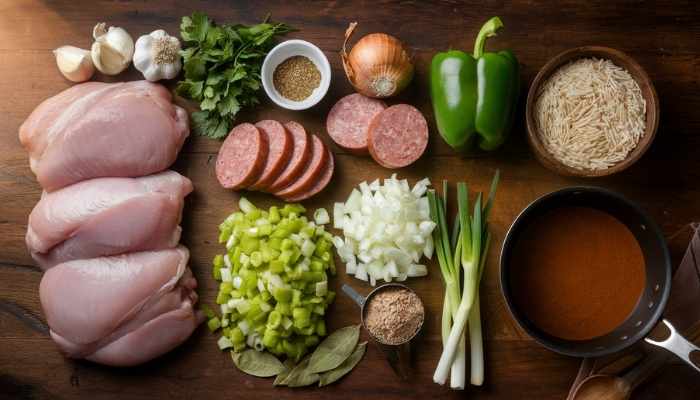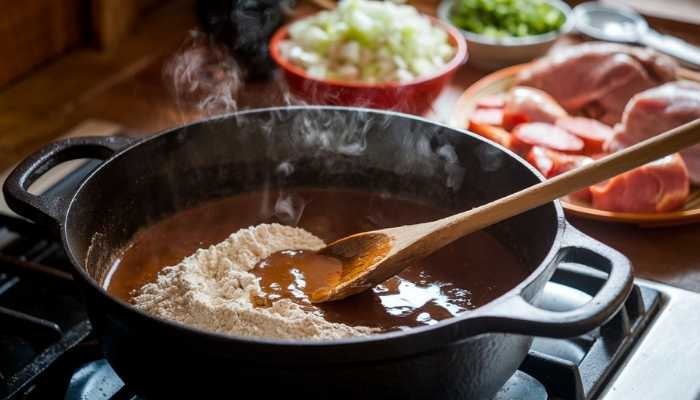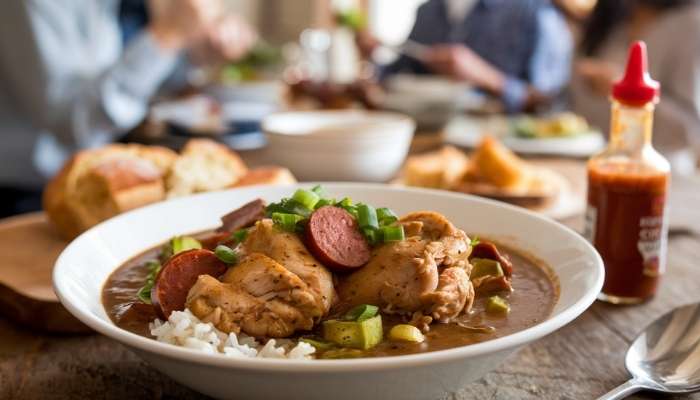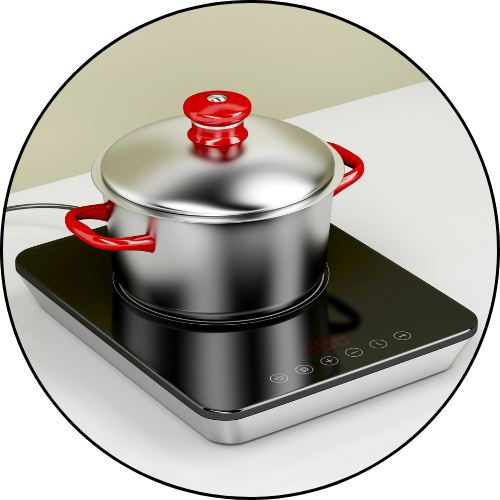If you’re craving a dish that brings warmth, flavor, taste and a touch of Southern tradition to your table, look no further than this Chicken and Sausage Gumbo recipe.
Gumbo is more than just a dish and it’s a cultural treasure in Louisiana, blending French, African, and Spanish influences.
As you might know, gumbo can vary, with Creole and Cajun styles offering distinct takes, from ingredients to spices. Whether you’re using seafood, chicken, or sausage, each variation tells a unique story about the recipe.
Chicken and Sausage Gumbo, in particular, is a comforting and hearty choice, known for its deep flavors and satisfying texture.
This version, with its smoky sausage, tender chicken, and a touch of okra, offers a perfect balance of flavors that’ll warm you from the inside out.
In this following recipe, I’ll conduct you through creating a mouthwatering Chicken and Sausage Gumbo that’s both easy to follow and packed with authentic flavor.
Ready to create a dish that’s perfect for any occasion? Let’s dive in and bring a little piece of Louisiana into your kitchen!
Ingredients for Chicken and Sausage Gumbo

Main Ingredients
Chicken:
I recommend using boneless, skinless chicken thighs for their tenderness and rich flavor, but rotisserie chicken or even turkey can be great alternatives if you’re looking for a shortcut.
Sausage:
Andouille sausage is the classic choice for gumbo, bringing that smoky, spicy kick. If you can & it find it, any hearty smoked sausage will do the job.
Key Flavor Components
Roux:
The soul of gumbo is a rich roux made with equal parts flour and oil. It’s a slow, patient process, but the deep, nutty flavor it gives the dish is worth the wait.
The Holy Trinity:
A flavorful mix of green bell pepper, onion, and celery, this trio creates the base for gumbo’s aromatic foundation.
Garlic:
A couple of cloves of garlic go a long way in adding that extra layer of savory goodness.
Chicken Broth:
This acts as the liquid base, giving the gumbo it’s comforting, soupy consistency. Use a good-quality chicken broth to ensure flavor.
Seasoning and Thickeners
Cajun Seasoning:
A generous sprinkle of Cajun seasoning like Tony Chachere’s Creole Seasoning adds depth, heat, and a bit of saltiness.
Filé Powder:
This earthy, almost smoky powder made from sassafras leaves not only thickens the gumbo but also gives it a distinct flavor.
Bay Leaves:
Toss in a couple of bay leaves for a subtle, aromatic backdrop to the dish.
Okra:
Okra is a classic thickener, but I know it’s not everyone’s favorite due to its texture. When you’re not sure about it, feel free to leave it out, but it does contribute a unique taste and consistency.
Serving Ingredients
White Rice:
Gumbo and rice are inseparable. The fluffy rice soaks up the rich, flavorful broth, making every bite even better.
Fresh Parsley and Green Onions:
A sprinkle of fresh herbs brightens up the dish, adding color and a burst of freshness.
Hot Sauce:
For those who love a bit of heat, a dash of hot sauce will elevate the gumbo to the next level. These ingredients come together to make a dish that’s both comforting and full of bold flavors. Whether you’re a gumbo novice or a seasoned pro, this recipe will surely be a crowd pleaser!
Preparation Steps for Chicken and Sausage Gumbo
Ingredient Prep
Start by washing and chopping your vegetables:
slice the green bell pepper, dice the onion, and chop the celery. These ingredients form the base of your gumbo’s flavor profile.
Mincemeat a few cloves of garlic to add some aromatic depth. Slice the sausage into rounds, and cut the chicken thighs into bite sized pieces.
If you’re serving your gumbo with rice, now’s a good time to cook the rice according to package instructions, nothing too complicated, just some fluffy white rice to serve as the perfect base for your gumbo.
Cooking Process
Sear Chicken and Sausage
To kick things off, heat a little oil in your pot and start by searing the sausage. You want to get itnicely browned on all sides, letting those flavorful drippings build up in the pot.
Once the sausage is browned, remove it and set it aside. Next, sear your chicken thighs in the same pot, working in batches if necessary. You’re looking for a good golden brown on each side, which adds flavor to the gumbo base.
If the chicken is cooked through, set it aside. Don’t throw away those delicious drippings; they’ll help you build the roux.
Making the Roux
Now, for the magic making the roux. In the same pot, add equal parts flour and oil (about ¼ cup of each should do for a nice, hearty batch). Stir continuously, as the flour and oil cook together.

The purpose here is to get the roux to a dark brown, almost chocolate like color. It’ll take some patience, about 15 to 20 minutes but don’t rush it. If the roux burns, you’ll have to start over.
So keep stirring and keep the heat moderate. A good roux is the backbone of a rich, flavorful gumbo.
Adding the Holy Trinity
On time your roux has reached that perfect deep brown, add your Holy Trinity bell pepper, onion, celery, and garlic. These vegetables will soften and release their flavors into the roux.
You’ll start to smell the goodness that is the foundation of your gumbo’s flavor. Let them cook down for a few minutes until they’re soft and fragrant.
Simmering the Gumbo
Next, gradually add your chicken broth. You want to avoid shocking the roux with cold liquid, so if the broth is at room temperature or slightly warmed, that’s ideal. Stir well to incorporate the roux into the broth, creating a smooth base.

Add the cooked chicken and sausage back into the pot, along with the Cajun seasoning, filé powder, bay leaves, and if you like, okra for that traditional thickening effect. Bring everything to a simmer and let it cook for at least an hour.
The flavors need time to meld together, so be patient. As it simmers, you’ll notice the gumbo thickening and the aromas becoming even richer.
Final Adjustments
After your gumbo has simmered and the flavors have had time to develop, it’s time for the final taste test. Give it a good stir and check the seasoning.
Depending on your taste, you might want to add a little more Cajun seasoning, salt, or pepper. Please be concerned to check if you want more filé powder or hot sauce for extra flavor or heat.
And there you have it! A flavorful, hearty Chicken and Sausage Gumbo ready to be served with rice, garnished with fresh parsley and green onions for a pop of color and freshness. Enjoy the taste!
Serving Suggestions for Chicken and Sausage Gumbo
How to Serve the Gumbo
When you’re ready to enjoy your gumbo, start by ladling a generous portion into a bowl. Traditionally, gumbo is served over a bed of fluffy white rice, which helps balance the bold flavors of the stew.
If you’ve got your gumbo, garnish it with a sprinkle of fresh parsley and chopped green onions for a pop of color and a burst of freshness. For those who enjoy a little extra kick, don’t forget to add a few dashes of hot sauce that adds both heat and depth to the dish.

Flavor Variations
While this recipe is delicious as is, gumbo is a versatile dish that can be personalized to your taste. Experiment with different spices or herbs like thyme, smoked paprika, or cayenne pepper to adjust the heat and flavor profile.
You can also top your gumbo with a dollop of sour cream or even fried onions for some added texture. Let your creativity take the lead!
Leftover Storage and Reheating for Chicken and Sausage Gumbo
Storing Leftovers
If you & lucky enough to have leftovers, store your gumbo in airtight containers for maximum freshness. Let it cool to room temperature before sealing to avoid condensation, which can affect the flavor.
You can refrigerate your gumbo for up to 3 days. If you plan to keep it longer, consider freezing it. Just make sure to use a freezer safe container, and it can last up to 3 months in the freezer.
Reheating Tips
When you & ready to enjoy your leftover gumbo, reheating is easy! The stovetop is the best method to preserve the flavors, so simply heat it in a pot over medium low heat, stirring occasionally.
If you find the gumbo too thick, add a little water or chicken broth to get the desired consistency. Alternatively, you can use the microwave, but be sure to heat it in intervals, stirring each time to ensure it heats evenly.
Remember, reheating multiple times can cause the flavors to degrade, so only reheat what you plan to eat!
Variations of Gumbo
Gumbo without Tomatoes vs. With Tomatoes
The great debate around gumbo often revolves around the inclusion of tomatoes. Traditional Cajun gumbo typically does not feature tomatoes, maintaining a rich, dark broth based on the roux and flavorful stock.
However, some Creole recipes do incorporate tomatoes, adding a tangy depth and vibrant color. If you prefer the classic, hearty taste of a non tomato gumbo, stick with the original.
But if you’re open to a slightly different flavor profile, adding diced tomatoes can give your gumbo a bright, zesty twist. It’s all about personal preference, so feel free to experiment and find what suits your taste.
Meat and Seafood Variations
One of the joys of gumbo is its versatility. Whole chicken and sausage are popular choices, you can easily switch things up. Adding shrimp, crab, or other seafood gives your gumbo a delightful coastal flair.
For a heartier version, you could throw in some smoked sausage, ham, or even duck. Meatless gumbo is also an option if you & looking for a lighter, vegetarian alternative.
The beauty of gumbo is that you can play around with various proteins, combining meats and seafood, or even making it with all vegetables. It’s a great way to customize your gumbo to your liking.
Roux Differences
The roux is the soul of gumbo, and it can vary depending on the recipe. A dark roux, which is made by cooking flour and oil until they reach a rich, chocolate brown color, is the hallmark of a traditional Cajun gumbo.
This deep color imparts a nutty, smoky flavor that is essential to the dish. On the other hand, a light roux is typically used in Creole gumbo, where the roux is cooked for a shorter time, resulting in a more subtle, less intense flavor.
The choice between dark and light roux can dramatically change the final taste of your gumbo, so try both to discover which one you prefer for your gumbo creation!
Gumbo’s Cultural Significance
Historical Context
Gumbo’s origins are deeply intertwined with Louisiana’s diverse history, shaped by the blending of African, French, Spanish, and Native American culinary traditions.
The dish’s name itself comes from the West African word “gombo,” referring to okra, which was used as a key ingredient in early versions of the dish. Enslaved African people brought okra and other key cooking techniques to Louisiana, while French settlers contributed the use of roux (a flour and fat mixture) as a thickener.
Spanish influence is evident in the use of rice and seasonings, and the Native American influence comes through the inclusion of indigenous ingredients like corn and game meats.
Over time, these diverse cultural threads wove together to create gumbo, a dish that embodies Louisiana’s history of cultural exchange and adaptation.
Gumbo as a Symbol of Southern Comfort Food
In Louisiana, gumbo is more than just a dish; it is a symbol of Southern hospitality and comfort. It is the kind of food that brings people together, whether for a family meal, a community gathering, or a celebration.
The hearty stew is often cooked in large pots, perfect for serving many, and is typically shared among family and friends. Its rich, complex flavors are both satisfying and nurturing, making it a go-to comfort food for those seeking warmth, connection, and tradition.
The surprising matter is that Gumbo also plays an integral role in major festivals and holidays like Mardi Gras, where it is served alongside other classic Louisiana dishes. It is a reminder of the importance of food in Louisiana & culture and offering of love, community, and hospitality.
Variations Across Louisiana
Gumbo is a dish that reflects the regional diversity of Louisiana. From the bays and swamps to the bustling streets of New Orleans, the gumbo you find in each part of the state is a product of local culture, ingredients, and family traditions.
In coastal areas like New Orleans, gumbo often features a mix of seafood such as shrimp, crab, and oysters while in more rural regions, it may include game meats like rabbit, duck, or even squirrel. Cajun gumbo, typical of the countryside, is usually spicier and made with a darker roux, while Creole gumbo from urban areas like New Orleans may incorporate tomatoes and a lighter roux.
Regardless of the region, gumbo is a dish that adapts to local tastes and traditions, yet always maintains its status as a central part of Louisiana’s rich food heritage.
Final Thought
Gumbo isn’t just a meal it’s an experience, a story simmered together with flavors as rich and diverse as the culture it represents. Whether you’re savoring a bowl of hearty chicken and sausage gumbo or indulging in a seafood-loaded variation, you’re partaking in a tradition that spans generations.
From the precise art of crafting the perfect roux to the joy of sharing this comforting dish with loved ones, gumbo is more than food; it & a celebration of community, heritage, and soul.
So, whether you & a seasoned cook or a first-time gumbo maker, embrace the process, add your personal touch, and most importantly, enjoy every delicious bite.
After all, gumbo is Louisiana’s way of reminding us that the best things in life are made to be shared. Laissez les bons temps rouler!




